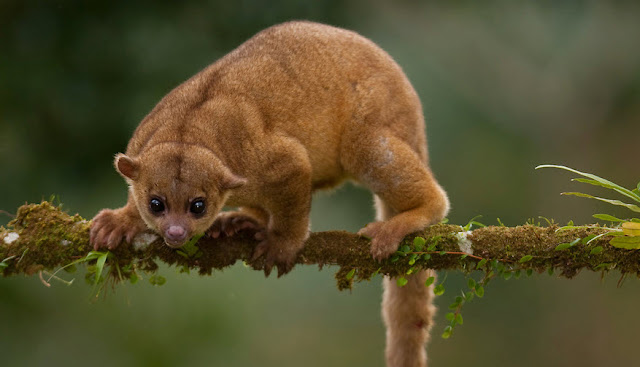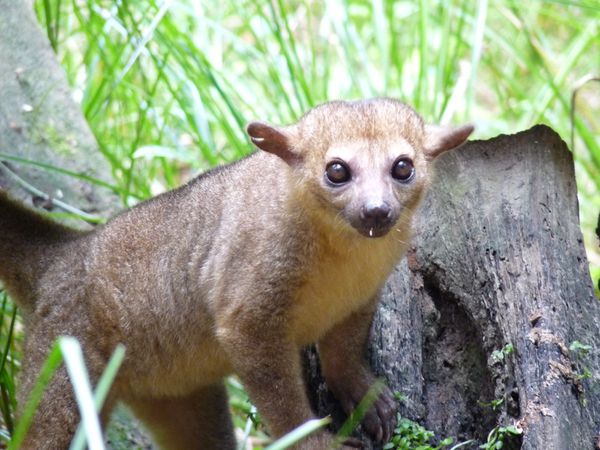Native to Central America and South America, this mostly frugivorous, arboreal mammal is not an endangered species, though it is seldom seen by people because of its strict nocturnal habits. However, they are hunted for the pet trade, for their fur (to make wallets and horse saddles) and for their meat. The species has been included in Appendix III of CITES by Honduras, which means that exports from Honduras require an export permit and exports from other countries require a certificate of origin or re-export.[2] They may live up to 40 years in captivity.
Size and appearance
An adult kinkajou weighs 1.4–4.6 kg (3–10 lb). The adult body length is 40–60 cm (16–24 in); in addition to body length, the length of the prehensile tail is 40–60 cm (16–24 in).[3] The kinkajou's woolly fur consists of an outer coat of gold (or brownish-gray) overlapping a gray undercoat. It has large eyes and small ears. It also has short legs with five toes on each foot and sharp claws.[4][5]Range and habitat
Kinkajous range from east and south of the Sierra Madres in Mexico, throughout Central America to Bolivia east of the Andes and the Atlantic Forest of southeastern Brazil. Their altitudinal range is from sea level to 2500 m. They are found in closed-canopy tropical forests, including lowland rainforest, montane forest, dry forest, gallery forest and secondary forest. Deforestation is thus a potential threat to the species.[1]
Diet
Kinkajou skull
The kinkajou's slender five-inch extrudable tongue helps the animal to obtain fruit and to lick nectar from flowers, so that it sometimes acts as a pollinator. (Nectar is also sometimes obtained by eating entire flowers.) Although captive specimens will avidly eat honey (hence the name "honey bear"), honey has not yet been observed in the diet of wild kinkajous.[citation needed]
Phylogeny
Olingos are similar to the kinkajou in morphology and habits. However, genetic studies have shown that kinkajous were an early offshoot of the ancestral procyonid line and are not closely related to any of the other extant procyonids, to which they are a sister group.[8][9][10] This divergence is thought to have occurred about 22.6 million years ago.[9] The similarities between the kinkajou and olingos are thus an example of parallel evolution; the closest relatives of the olingos are actually the coatis.[8][9][10] The kinkajou is distinguished from olingos by its prehensile tail, its foreshortened muzzle, its extrudable tongue, and its lack of anal scent glands.[11] The only other carnivoran with a prehensile tail is the binturong of Southeast Asia.Kinkajous evolved in Central America and invaded the formerly isolated continent of South America several million years ago, as part of the Great American Interchange, when formation of the Isthmus of Panama made it possible to do so.[8]
Behavior
Kinkajou skeleton on display at the Museum of Osteology
Potos flavus
A nocturnal animal, the kinkajou's peak activity is usually between about 7:00 PM and midnight, and again an hour before dawn. During daylight hours, kinkajous sleep in tree hollows or in shaded tangles of leaves, avoiding direct sunlight.
Kinkajous breed throughout the year, giving birth to one or occasionally two small babies after a gestation period of 112 to 118 days.
As pets
Yawning kinkajou in a Costa Rican animal shelter
In El Salvador, Guatemala and Honduras pet kinkajous are commonly called micoleón, meaning "lion monkey". In Peru pet kinkajous are commonly referred to as "lirón". The lirón is often described as a "bear-monkey" or "bear-monkey hybrid".
They live an average of about 23 years in captivity, with a maximum recorded life span of 41 years.[16]









No comments:
Post a Comment
Note: Only a member of this blog may post a comment.